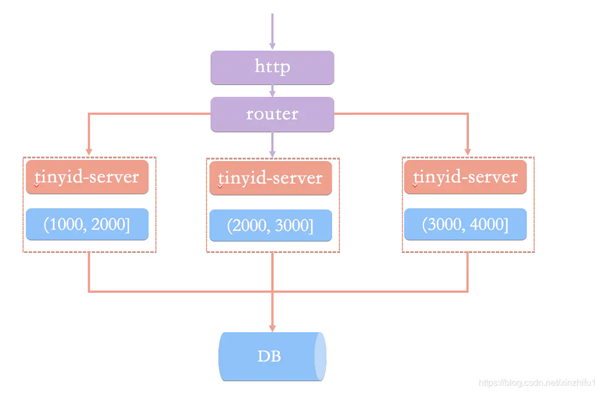本篇内容介绍了“什么是分布式ID生成器Tinyid”的有关知识,在实际案例的操作过程中,不少人都会遇到这样的困境,接下来就让小编带领大家学习一下如何处理这些情况吧!希望大家仔细阅读,能够学有所成!
Tinyid的特性
全局唯一的long型ID
趋势递增的id
提供 http 和 java-client 方式接入
支持批量获取ID
支持生成1,3,5,7,9...序列的ID
支持多个db的配置
适用场景:只关心ID是数字,趋势递增的系统,可以容忍ID不连续,可以容忍ID的浪费
不适用场景:像类似于订单ID的业务,因生成的ID大部分是连续的,容易被扫库、或者推算出订单量等信息
Tinyid原理
Tinyid是基于号段模式实现,再简单啰嗦一下号段模式的原理:就是从数据库批量的获取自增ID,每次从数据库取出一个号段范围,例如 (1,1000] 代表1000个ID,业务服务将号段在本地生成1~1000的自增ID并加载到内存.。
Tinyid会将可用号段加载到内存中,并在内存中生成ID,可用号段在首次获取ID时加载,如当前号段使用达到一定比例时,系统会异步的去加载下一个可用号段,以此保证内存中始终有可用号段,以便在发号服务宕机后一段时间内还有可用ID。
原理图大致如下图:

Tinyid原理图
Tinyid实现
Tinyid的GitHub地址 :https://github.com/didi/tinyid.git
Tinyid提供了两种调用方式,一种基于Tinyid-server提供的http方式,另一种Tinyid-client客户端方式。不管使用哪种方式调用,搭建Tinyid都必须提前建表tiny_id_info、tiny_id_token。
CREATE TABLE `tiny_id_info` ( `id` bigint(20) unsigned NOT NULL AUTO_INCREMENT COMMENT '自增主键', `biz_type` varchar(63) NOT NULL DEFAULT '' COMMENT '业务类型,唯一', `begin_id` bigint(20) NOT NULL DEFAULT '0' COMMENT '开始id,仅记录初始值,无其他含义。初始化时begin_id和max_id应相同', `max_id` bigint(20) NOT NULL DEFAULT '0' COMMENT '当前最大id', `step` int(11) DEFAULT '0' COMMENT '步长', `delta` int(11) NOT NULL DEFAULT '1' COMMENT '每次id增量', `remainder` int(11) NOT NULL DEFAULT '0' COMMENT '余数', `create_time` timestamp NOT NULL DEFAULT '2010-01-01 00:00:00' COMMENT '创建时间', `update_time` timestamp NOT NULL DEFAULT '2010-01-01 00:00:00' COMMENT '更新时间', `version` bigint(20) NOT NULL DEFAULT '0' COMMENT '版本号', PRIMARY KEY (`id`), UNIQUE KEY `uniq_biz_type` (`biz_type`) ) ENGINE=InnoDB AUTO_INCREMENT=1 DEFAULT CHARSET=utf8 COMMENT 'id信息表'; CREATE TABLE `tiny_id_token` ( `id` int(11) unsigned NOT NULL AUTO_INCREMENT COMMENT '自增id', `token` varchar(255) NOT NULL DEFAULT '' COMMENT 'token', `biz_type` varchar(63) NOT NULL DEFAULT '' COMMENT '此token可访问的业务类型标识', `remark` varchar(255) NOT NULL DEFAULT '' COMMENT '备注', `create_time` timestamp NOT NULL DEFAULT '2010-01-01 00:00:00' COMMENT '创建时间', `update_time` timestamp NOT NULL DEFAULT '2010-01-01 00:00:00' COMMENT '更新时间', PRIMARY KEY (`id`) ) ENGINE=InnoDB AUTO_INCREMENT=1 DEFAULT CHARSET=utf8 COMMENT 'token信息表'; INSERT INTO `tiny_id_info` (`id`, `biz_type`, `begin_id`, `max_id`, `step`, `delta`, `remainder`, `create_time`, `update_time`, `version`) VALUES (1, 'test', 1, 1, 100000, 1, 0, '2018-07-21 23:52:58', '2018-07-22 23:19:27', 1); INSERT INTO `tiny_id_info` (`id`, `biz_type`, `begin_id`, `max_id`, `step`, `delta`, `remainder`, `create_time`, `update_time`, `version`) VALUES (2, 'test_odd', 1, 1, 100000, 2, 1, '2018-07-21 23:52:58', '2018-07-23 00:39:24', 3); INSERT INTO `tiny_id_token` (`id`, `token`, `biz_type`, `remark`, `create_time`, `update_time`) VALUES (1, '0f673adf80504e2eaa552f5d791b644c', 'test', '1', '2017-12-14 16:36:46', '2017-12-14 16:36:48'); INSERT INTO `tiny_id_token` (`id`, `token`, `biz_type`, `remark`, `create_time`, `update_time`) VALUES (2, '0f673adf80504e2eaa552f5d791b644c', 'test_odd', '1', '2017-12-14 16:36:46', '2017-12-14 16:36:48');tiny_id_info表是具体业务方号段信息数据表

max_id :号段的最大值
step:步长,即为号段的长度
biz_type:业务类型
号段获取对max_id字段做一次update操作,update max_id= max_id + step,更新成功则说明新号段获取成功,新的号段范围是(max_id ,max_id +step]。
tiny_id_token是一个权限表,表示当前token可以操作哪些业务的号段信息。

修改tinyid-server中 \offline\application.properties 文件配置数据库,由于tinyid支持数据库多master模式,可以配置多个数据库信息。启动 TinyIdServerApplication 测试一下。
datasource.tinyid.primary.driver-class-name=com.mysql.jdbc.Driver datasource.tinyid.primary.url=jdbc:mysql://127.0.0.1:3306/xin-master?autoReconnect=true&useUnicode=true&characterEncoding=UTF-8 datasource.tinyid.primary.username=junkang datasource.tinyid.primary.password=junkang datasource.tinyid.primary.testOnBorrow=false datasource.tinyid.primary.maxActive=10 datasource.tinyid.secondary.driver-class-name=com.mysql.jdbc.Driver datasource.tinyid.secondary.url=jdbc:mysql://localhost:3306/db2?autoReconnect=true&useUnicode=true&characterEncoding=UTF-8 datasource.tinyid.secondary.username=root datasource.tinyid.secondary.password=123456 datasource.tinyid.secondary.testOnBorrow=false datasource.tinyid.secondary.maxActive=101、Http方式
tinyid内部一共提供了四个http接口来获取ID和号段。
package com.xiaoju.uemc.tinyid.server.controller; /** * @author du_imba */ @RestController @RequestMapping("/id/") public class IdContronller { private static final Logger logger = LoggerFactory.getLogger(IdContronller.class); @Autowired private IdGeneratorFactoryServer idGeneratorFactoryServer; @Autowired private SegmentIdService segmentIdService; @Autowired private TinyIdTokenService tinyIdTokenService; @Value("${batch.size.max}") private Integer batchSizeMax; @RequestMapping("nextId") public Response<List<Long>> nextId(String bizType, Integer batchSize, String token) { Response<List<Long>> response = new Response<>(); try { IdGenerator idGenerator = idGeneratorFactoryServer.getIdGenerator(bizType); List<Long> ids = idGenerator.nextId(newBatchSize); response.setData(ids); } catch (Exception e) { response.setCode(ErrorCode.SYS_ERR.getCode()); response.setMessage(e.getMessage()); logger.error("nextId error", e); } return response; } @RequestMapping("nextIdSimple") public String nextIdSimple(String bizType, Integer batchSize, String token) { String response = ""; try { IdGenerator idGenerator = idGeneratorFactoryServer.getIdGenerator(bizType); if (newBatchSize == 1) { Long id = idGenerator.nextId(); response = id + ""; } else { List<Long> idList = idGenerator.nextId(newBatchSize); StringBuilder sb = new StringBuilder(); for (Long id : idList) { sb.append(id).append(","); } response = sb.deleteCharAt(sb.length() - 1).toString(); } } catch (Exception e) { logger.error("nextIdSimple error", e); } return response; } @RequestMapping("nextSegmentId") public Response<SegmentId> nextSegmentId(String bizType, String token) { try { SegmentId segmentId = segmentIdService.getNextSegmentId(bizType); response.setData(segmentId); } catch (Exception e) { response.setCode(ErrorCode.SYS_ERR.getCode()); response.setMessage(e.getMessage()); logger.error("nextSegmentId error", e); } return response; } @RequestMapping("nextSegmentIdSimple") public String nextSegmentIdSimple(String bizType, String token) { String response = ""; try { SegmentId segmentId = segmentIdService.getNextSegmentId(bizType); response = segmentId.getCurrentId() + "," + segmentId.getLoadingId() + "," + segmentId.getMaxId() + "," + segmentId.getDelta() + "," + segmentId.getRemainder(); } catch (Exception e) { logger.error("nextSegmentIdSimple error", e); } return response; } }nextId、nextIdSimple都是获取下一个ID,nextSegmentIdSimple、getNextSegmentId是获取下一个可用号段。区别在于接口是否有返回状态。
nextId: 'http://localhost:9999/tinyid/id/nextId?bizType=test&token=0f673adf80504e2eaa552f5d791b644c' response : { "data": [2], "code": 200, "message": "" } nextId Simple: 'http://localhost:9999/tinyid/id/nextIdSimple?bizType=test&token=0f673adf80504e2eaa552f5d791b644c' response: 3

2、Tinyid-client客户端
如果不想通过http方式,Tinyid-client客户端也是一种不错的选择。
引用 tinyid-server包
<dependency> <groupId>com.xiaoju.uemc.tinyid</groupId> <artifactId>tinyid-client</artifactId> <version>${tinyid.version}</version> </dependency>启动 tinyid-server项目打包后得到 tinyid-server-0.1.0-SNAPSHOT.jar ,设置版本 ${tinyid.version}为0.1.0-SNAPSHOT。
在我们的项目 application.properties 中配置 tinyid-server服务的请求地址 和 用户身份token
tinyid.server=127.0.0.1:9999 tinyid.token=0f673adf80504e2eaa552f5d791b644c```在Java代码调用TinyId也很简单,只需要一行代码。
// 根据业务类型 获取单个ID Long id = TinyId.nextId("test"); // 根据业务类型 批量获取10个ID List<Long> ids = TinyId.nextId("test", 10);Tinyid整个项目的源码实现也是比较简单,像与数据库交互更直接用jdbcTemplate实现
@Override public TinyIdInfo queryByBizType(String bizType) { String sql = "select id, biz_type, begin_id, max_id," + " step, delta, remainder, create_time, update_time, version" + " from tiny_id_info where biz_type = ?"; List<TinyIdInfo> list = jdbcTemplate.query(sql, new Object[]{bizType}, new TinyIdInfoRowMapper()); if(list == null || list.isEmpty()) { return null; } return list.get(0); }“什么是分布式ID生成器Tinyid”的内容就介绍到这里了,感谢大家的阅读。如果想了解更多行业相关的知识可以关注亿速云网站,小编将为大家输出更多高质量的实用文章!
亿速云「云服务器」,即开即用、新一代英特尔至强铂金CPU、三副本存储NVMe SSD云盘,价格低至29元/月。点击查看>>
免责声明:本站发布的内容(图片、视频和文字)以原创、转载和分享为主,文章观点不代表本网站立场,如果涉及侵权请联系站长邮箱:is@yisu.com进行举报,并提供相关证据,一经查实,将立刻删除涉嫌侵权内容。
原文链接:https://mp.weixin.qq.com/s/-9ecQmAE1faC3r8j1eDLHw